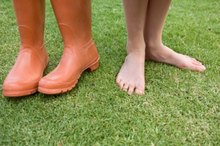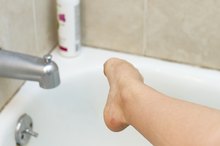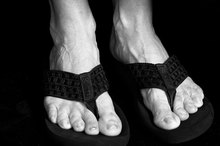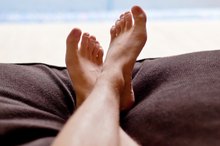What does fact checked mean?
At Healthfully, we strive to deliver objective content that is accurate and up-to-date. Our team periodically reviews articles in order to ensure content quality. The sources cited below consist of evidence from peer-reviewed journals, prominent medical organizations, academic associations, and government data.
The information contained on this site is for informational purposes only, and should not be used as a substitute for the advice of a professional health care provider. Please check with the appropriate physician regarding health questions and concerns. Although we strive to deliver accurate and up-to-date information, no guarantee to that effect is made.
How to Remove Corns Permanently
Corns are essentially calluses that appear on toes, notes the Cleveland Clinic 1. Due to continuous irritation, skin on the toe begins to thicken and harden. This response to chronic friction or pressure is a defensive mechanism with which the skin protects against blistering or ulcers. Left unchecked, corns become painful and can make walking difficult. While you can remove corns at home, those with diabetes or other conditions causing inhibited circulation should seek treatment advice from their doctor.
Apply an astringent foot powder and wear polyester-cotton blend socks to reduce perspiration, if it is a problem. Irritation from sweat and friction contributes to corns. Apply an astringent or over-the-counter foot powder daily, suggests the Cleveland Clinic 1. Cornstarch or talcum powder are other effective options, according to Suzanne M. Levine, D.P.M., a podiatrist at Mount Sinai Hospital in "The Doctors Book of Home Remedies." Wear socks made from a blend of polyester and cotton, as they wick moisture away from the skin.
How to Remove Foot Corns Naturally
Learn More
Replace shoes that are too tight, particularly if they're tight in the tips around the toes. This is a leading cause of corns, notes the Cleveland Clinic 1. Without eliminating the source of friction or pressure that led to the corn, it will be difficult to remove and will likely recur.
Wear a corn pad around the corn before removal. These doughnut-shaped linings protect the corn from further irritation and prevent growth. Opt for one containing salicylic acid, which helps remove the dead skin on the corn and begins to soften the growth, the Nemours Foundation explains 2.
How Does Corn Removal Work?
Learn More
Make a foot bath with warm water and a small amount of liquid soap. Soak the foot with the corn for about 10 minutes.
Wet a pumice stone. Rub it lightly across the corn, using a side-to-side motion. Rinse the stone and your foot periodically to remove small bits of flaking pumice. Continue until the corn is sanded down almost to the surface of your skin. Be careful not to reach the surface of healthy skin.
Continue wearing a non-medicated corn pad around the treated area for a day or two to prevent irritation, blisters or recurrence.
Tips
If you cut your skin while using a pumice stone, apply a topical antibiotic agent and cover the wound with a bandage. Use your pumice stone in the bath or shower as an alternative to the method of soaking and rinsing your feet. Wash your foot first. Foam wedges are available that fit between the toes to eliminate friction.
Warnings
See your doctor if corns are a chronic problem. It is possible that an abnormality in your foot structure causes continuous pressure or friction. Some people can remedy the problem with special shoe inserts, while others may need surgical restructuring to correct the problem permanently, explains the Cleveland Clinic.
Related Articles
References
- Cleveland Clinic: Corns
- Nemours Foundation: Blisters, Calluses and Corns
- MotherNature.com: Foot Odor
- DeLauro T and DeLauro M (2012) Chapter 98: Corns and Calluses. Fitzpatrick's Dermatology in General Medicine (8th Edition). New York, New York: McGraw-Hill Education. ISBN-13: 978-0071669047.
- American Academy of Dermatology Association. How to treat corns and calluses. 2019.
- Reddy P, Anusha T, Haritha N, Nagendra A, Bhavani D, Gandhimathi R. Case report on non-surgical treatment for foot corn. International Journal of Dermatopathology and Surgery. 2018;4(1).
- American Academy of Dermatology Association. How to Treat Corns and Calluses. 2019.
- DeLauro T and DeLauro M (2012) Chapter 98: Corns and Calluses. Fitzpatrick's Dermatology in General Medicine (8th Edition). New York, New York: McGraw-Hill Education. ISBN-13: 978-0071669047.
Writer Bio
Eric Mohrman has been a freelance writer since 2007, focusing on travel, food and lifestyle stories. His creative writing is also widely published. He lives in Orlando, Florida.







